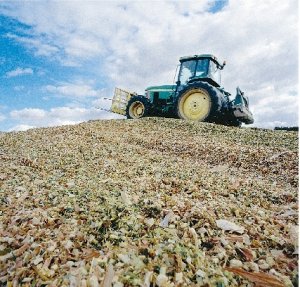Maize silage contains a high concentration of starch and sugars. This makes it more prone to heating when the stack or bunker is opened at feed-out time. When silage heats it loses valuable nutrients which could have been used by the cow to produce milk. There are two main ways you can reduce heating in your maize silage - apply the right silage inoculant and use good harvest, storage and feed-out management techniques.
Silage inoculants
Aerobic stability is a measure of how long silage stays cool when it is exposed to the air at feed-out time. A recent paper presented at the New Zealand Grasslands Association conference1, compared the aerobic stability of eight different maize silages inoculated with three commercially available silage inoculants.
Harvest management
Good harvest, storage and feed-out techniques can also reduce silage heating.
Best-practice guidelines are as follows:
Harvest your maize silage crop when the drymatter is between 30-38%. Crops which are >38% drymatter are more difficult to compact resulting in a slower fermentation and greater losses when the stack is exposed to the air at feed-out time. Some of the potential negative outcomes for very dry crops can be reduced by chopping the maize shorter and spreading it into thinner layers as the stack is being formed.
Chop to 10 – 15mm. This is a theoretical chop length and you will find some particles that are shorter or longer in your silage. Some longer particles are beneficial as they stimulate the rumen of the animal that is being fed. If your silage is very dry (greater than 38% drymatter), decrease the chop length to 5-9 mm. In the case of very wet crops (less than 30% drymatter) chop length may be increased up to 20 mm.
Use a plant processor to ensure that 99% (target minimum 80%) of the kernels are broken into at least four pieces. A plant processor will also break down larger pieces of plant material (e.g. the core of the maize cob) assisting the compaction process and reducing feed-out wastage.
Spread the maize in thin layers and compact it well. Compaction is a function of vehicle weight, rolling time and the depth of the layers of chopped maize that is being compacted. Thin layers (100-150mm) compact to a higher density than thick layers.
Seal the stack or bunker completely. Compaction removes air from the forage and sealing keeps it out. Ideally the stack should be covered and sealed immediately after harvest as this will speed the fermentation process and reduce losses. Tape holes and joins and weight the cover down using tyres that are touching, sand bags or lime. Sand or limestone should be used to seal around the edges of the bunker or stack.
Control rats and mice. Keep the stack area free of weeds that can provide cover for rats. Place rat baits in bait stations around the stack and ensure they are checked and replenished on a regular basis.
Feed out carefully. Keep the stack or bunker face tight throughout the feed-out period and remove loose material on a daily basis.
Remember silage heating will cost you production. Applying the right inoculant and using good harvest management, storage and feed-out techniques will help keep your maize silage cool and put more milk in your vat this season.
1Kleinmans et al, 2011. Using silage inoculants to improve the quality of pasture and maize silage in NZ. Proceedings of the NZ Grassland Association 73: 75-80. For maximum aerobic stability benefits, silage must ferment at least 30 days before feeding.
• Ian Williams is a Pioneer forage specialist. Contact him at This email address is being protected from spambots. You need JavaScript enabled to view it..









